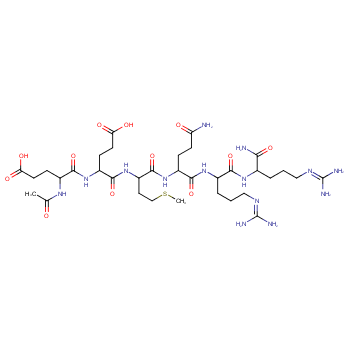 |
Commonly known as Botulinum-like bacteria, by applying hexapeptides and compounding amino acids into a structure similar to Botox, it can block the nerve transmission of muscle contraction information, affect the skin nerve conduction, and relax the facial muscles. Achieve the purpose of smoothing dynamic lines, static lines and fine lines. It also prevents wrinkles caused by excessive release of catecholamines, such as wrinkles caused by repeated stimulation of mature skin on the face. Effectively soothes and inhibits the contraction and activity of muscles around forehead wrinkles, eye crow's tail lines and wrinkles, helps muscles relax, restores skin elastic tissue to supple and smooth lines, and reduces facial fine lines. It has the effects of Botox but without the side effects of injectable Botulinum toxin A.

Acetyl hexapeptide-3, also known as Argireline or botulinum toxin mimetic factor, is a small molecule composed of six amino acids. Since its amino acid sequence is the main functional position of the nerve conduction inhibition zone that simulates botulinum toxin (SNAP-25), it has a similar nerve conduction inhibition function, which can relax expression lines caused by nervous tension and slow down facial wrinkles. and cellular aging. Since hexapeptide is not botulinum toxin and is non-toxic, it is quite safe to use and is widely used in anti-aging skin care products.
To put it simply, peptides are composed of more than 2 amino acids, and amino acids are the main components of proteins. Therefore, some people say that peptides are the precursors of proteins, or the individual components of proteins. fragment. Since there are more than 20 types of amino acids, different types of amino acids, depending on the number of combinations and the order in which they are arranged, will form peptide categories with different effects. You may ask, many animals and plants contain amino acids, does that mean that peptides are ubiquitous? Indeed, in terms of the principle of composition, peptides seem to be everywhere, but the problem is that these purely natural peptides are From the expert point of view, peptides do not have skin care functions. Instead, they are synthesized with artificial technology. This is the only way to give peptides specific skin care effects.
Tracing back to the history of peptides, as early as the early 1980s, the growth factor isolated from human plasma was actually a fragment 3 peptide of the protein. On July 2, 2002, at the 20th Dermatology Congress held in Paris, research confirmed that 5-peptides, which are oligopeptides, are more effective in removing acne than vitamins A and C. Since then, peptides have become the mainstream ingredient in European and American anti-aging skin care products.
You Shanzhen, Assistant Professor of the Department of Medicinal Cosmetics of China Medical University, pointed out that peptides have the advantages of being absolutely natural, having a specific location of action, and being effective at a very small dose. They can be called the last channel of information before entering cells. By. It is very "short-lived", which is the main reason why peptides were difficult to discover in the first place. In addition, the safety and low irritation of peptides are unparalleled among current anti-aging ingredients. Compared with general chemical ingredients, although they are effective, they are also relatively irritating. Taking female hormones as an example, they have slow and strong effects. Long-term use may cause widespread effects, such as liver and kidney functions may deteriorate. .
Peptides are derived from the extraction of growth factors. Compared with the stability, safety and even smell of growth factors that are often questioned, peptides are manufactured to simulate human needs and are sorted according to different needs to achieve Anti-aging and other different effects.
Not only does the Da Vinci Code need to be explained, but recently, peptide skin care products have also appeared with digital codes! In fact, peptides are composed of small fragments of proteins, combined by different numbers and types of amino acids. What the different numbers represent is composed of several amino acids. The different amino acid sequences correspond to the different needs of the skin. Compared with beauty ingredients such as collagen, which have larger molecules, oligopeptides, which are composed of less than ten amino acids, have molecules at the nanometer level, so they are very easy to be absorbed by the skin. For example, 5-peptides are composed of 5 different amino acids. Currently, peptide numbers range from 2 to 100. The peptides that have been used in skin care products include 2, 3, 4, 5, 6, and 7. , 9 and other peptide ingredients.
Many people think that the larger the number of peptides, the better the effect. In fact, this is a wrong idea. The smaller the number, the easier it is to be absorbed by the skin. The size of the number also means that the depth of the action on the skin is different. For example: 2, 3, 4, 5, 6 and other peptides all have the function of promoting collagen proliferation, and their action sites are concentrated on fibroblasts, while molecules The main purposes of the larger peptides 7 and 9 are to fight free radicals, whiten, moisturize and moisturize. They are just right to act on the epidermis, but have no meaning on fibroblasts.
Many people in the beauty industry pointed out that in the past two years, beauty ingredients have "stagnated". Compared with the new beauty ingredients that were discovered all the time in the past, peptides have become irreplaceable anti-aging ingredients. , and more and more possible orderings are being discovered. The indisputable fact is that the digital game of peptides has not been played enough. Even in the near future, peptides will not only be the anti-aging protagonist in the beauty industry, but may also be the most supporting role in antioxidant, whitening, moisturizing and other skin care effects.
The skin care effects of peptides are primarily anti-aging and anti-wrinkle. Among them, pentapeptides and hexapeptides are the most well-known. The former (pentapeptides) can inhibit metal protein decomposing enzymes and stimulate collagen regeneration, while the latter (Hexapeptide), also known as botulinum toxin, can block the transmission between nerves and muscles, relax overactive muscles, and achieve the effect of smoothing surface fine lines and wrinkles such as dynamic lines and expression lines. Peptides are used for anti-aging, and there are other combinations of peptides that have functions such as activating the hormone estrogen, improving sagging breasts, and anti-eye bags.
As the name suggests, hexapeptide is a peptide composed of six amino acids, and pentapeptide is a peptide composed of five amino acids. The different mechanisms of the two components may also be different, but - generally speaking It is said that it is effective in anti-aging and wrinkle removal, especially on fine lines on the face. Take Acetyl Hexapeptide 3 (AH3) as an example. Its mechanism of action blocks the nerve transmission messages that cause muscle cells to contract. It can effectively relieve the contraction of facial wrinkle muscles, make the skin more supple and firm, and improve sleepiness. Dynamic lines caused by expressions, and reducing the occurrence of facial lines. If you want to reduce facial sagging, you may need to use Botox or hyaluronic acid.
 |